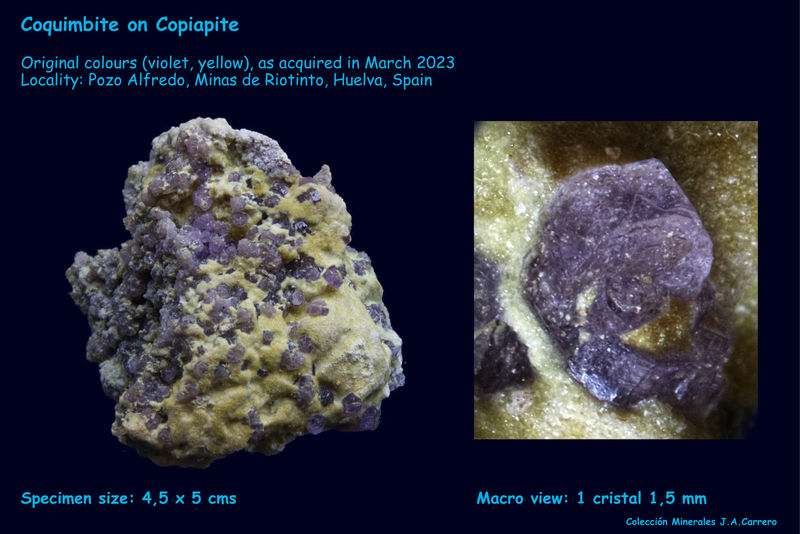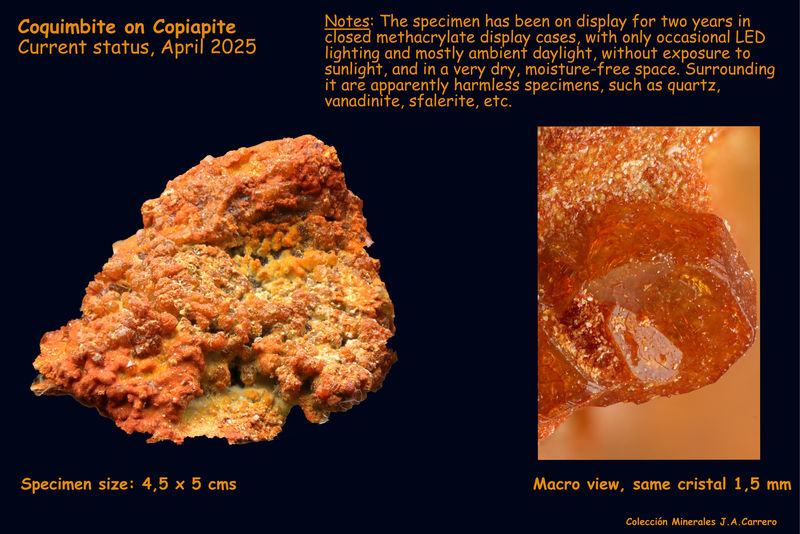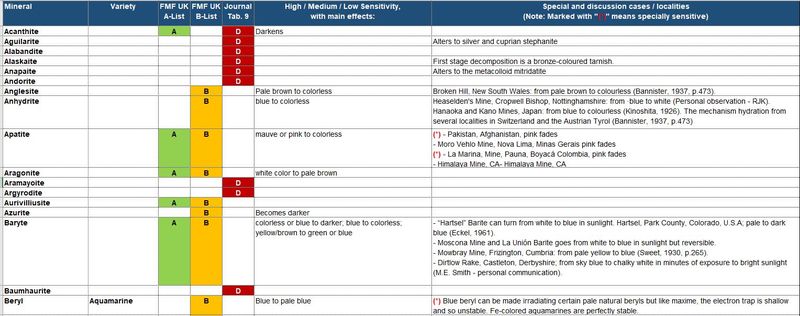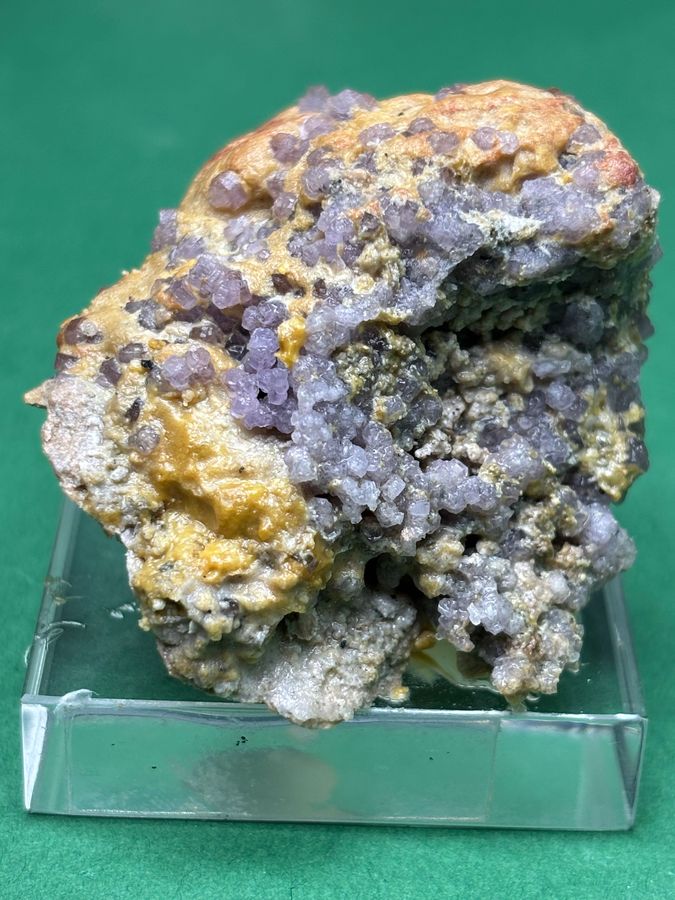| View previous topic :: View next topic |
| Author |
Message |
Jordi Fabre
Overall coordinator of the Forum

Joined: 07 Aug 2006
Posts: 5032
Location: Barcelona



|
|
| Back to top |
|
 |
Peter Lemkin
Joined: 18 Nov 2016
Posts: 403
Location: Prague


|
 Posted: Feb 12, 2024 02:42 Post subject: Re: Preparing a list of light sensitive minerals - (14) Posted: Feb 12, 2024 02:42 Post subject: Re: Preparing a list of light sensitive minerals - (14) |
|
|
Thanks. Anyone is welcome to work to combine the various sub-lists into one and annotate where necessary about certain locations or to explain for clarity. Not necessary, but a combined [or two separate] lists of 'light-effected' and 'heat-sensitive' minerals would be helpful - minerals that sometimes need special care in display, storage, etc. I'm not talking about intentional changing of the color of minerals mostly for gemological color.
I guess this could be made into a more complete project of 'minerals with special care needs': light sensitive; heat-sensitive; liable to chemically disintegrate (and methods to stabilize some); minerals that should not be near specific other minerals (or isolated), etc.
If one searches the internet there are some other such lists and if i remember Sinkankas made such a partial list in one of his books [I'd have, but no time to search through just now]. Must be a PhD Thesis out there somewhere on this.....;-)
Absolutely NOT needed, but for me of interest is the WHY/HOW some are sensitive to light; i.e., what mechanism light causes changes in. One must remember that all but surface minerals have spent thousands, millions or billions of years without light.
|
|
| Back to top |
|
 |
James Catmur
Site Admin

Joined: 14 Sep 2006
Posts: 1463
Location: Cambridge



|
 Posted: Feb 12, 2024 08:25 Post subject: Re: Preparing a list of light sensitive minerals - (14) Posted: Feb 12, 2024 08:25 Post subject: Re: Preparing a list of light sensitive minerals - (14) |
|
|
| - Barite, La Unión, Murcia, Spain / white -> blue
|
|
| Back to top |
|
 |
Jose Angel Carrero
Joined: 25 Oct 2023
Posts: 3


|
 Posted: May 21, 2025 13:57 Post subject: Re: Preparing a list of light sensitive minerals - (14) Posted: May 21, 2025 13:57 Post subject: Re: Preparing a list of light sensitive minerals - (14) |
|
|
Dear all,
I am an amateur collector from Madrid and a regular FMF user. I recently published a post about the condition of a piece in my collection (Coquimbita on Copiapita), the photos of which I share here.
My interest was to identify the causes of this dramatic color change (see photos). I received some responses (especially from James Catmur, thanks again), indicating that the most likely cause would be the light sensitivity of these minerals. At the same time, he shared links to this long thread from FMF UK (Light Sensitivity of Minerals), which in turn referenced a discussion forum on MINDAT.
MINDAT also referenced a document from The Russell Society, which offered a list of Light Sensitive Minerals, with two sections: Light Sensitive Minerals (color changes, no risk of decomposition) and Sensitive Minerals, with risk of decomposition.
By analyzing the posts on FMF and MINDAT in considerable detail, and by reviewing a List of Sensitive Minerals published on FMF UK and shared on MINDAT, in addition to the Russell Society document, I have compiled a complete list of the minerals referenced there, containing those classified as "A" (there is general agreement to consider the minerals on that list as "Sensitive") and "B" (cases of minerals where there is discussion regarding their sensitivity, including specific cases of sensitive minerals only in certain localities, etc.), and adding information on specific mentions, localities, etc., from the Russell Society report, and especially adding cases of minerals at risk of decomposition "in oxygen".
The current status of the list would require review by experts, such as those of you who are members of this forum, since I am an amateur collector with no special training in mineralogy or geology.
Therefore, hoping you find it interesting, the document (Microsoft Excel, PDF) should be reviewed, which I would email to the volunteer(s) to make the appropriate corrections. Subsequently, we will agree on the best format for publishing the list on FMF UK (and maybe to reference it in MINDAT), and then translate it into Spanish for publication on FMF Spain.
If you find it interesting, please provide me with the email address(es) so I can share the current document.
I look forward to hearing from you.
| Mineral: | Coquimbite Copiapite |
| Description: |
|
| Viewed: |
188 Time(s) |

|
| Mineral: | Coquimbite Copiapìte |
| Description: |
|
| Viewed: |
188 Time(s) |

|
| Description: |
| The current status of the list, looks like this excerpt. |
|
| Viewed: |
195 Time(s) |

|
|
|
| Back to top |
|
 |
Jose Angel Carrero
Joined: 25 Oct 2023
Posts: 3


|
 Posted: May 21, 2025 15:04 Post subject: Re: Preparing a list of light sensitive minerals - (14) Posted: May 21, 2025 15:04 Post subject: Re: Preparing a list of light sensitive minerals - (14) |
|
|
Correction: Instead of "FMF UK", it should be understood as "FMF - English Site"
Sorry.
|
|
| Back to top |
|
 |
alfredo
Site Admin

Joined: 30 Jan 2008
Posts: 1012



|
 Posted: May 21, 2025 16:53 Post subject: Re: Preparing a list of light sensitive minerals - (14) Posted: May 21, 2025 16:53 Post subject: Re: Preparing a list of light sensitive minerals - (14) |
|
|
| José Angel, In the case of your coquimbite turning brown, it is not the light but rather the dryness that is the problem. Coquimbite is only stable at atmospheric humidities between 30 < 70 %. Drier, it loses water; damper, it decomposes to brown oxyhydroxides and acid. Drying is reversible by moving to a more humid environment, with recuperation of the original color. If altered by too high humidity then that's irreversible.
|
|
| Back to top |
|
 |
Roger Warin

Joined: 23 Jan 2013
Posts: 1233



|
 Posted: May 22, 2025 04:09 Post subject: Re: Preparing a list of light sensitive minerals - (14) Posted: May 22, 2025 04:09 Post subject: Re: Preparing a list of light sensitive minerals - (14) |
|
|
Thanks, Alfredo,
You're right, all that crystallization water can never go back into the crystal lattice.
9 H2O!
|
|
| Back to top |
|
 |
Jose Angel Carrero
Joined: 25 Oct 2023
Posts: 3


|
 Posted: May 22, 2025 06:53 Post subject: Re: Preparing a list of light sensitive minerals - (14) Posted: May 22, 2025 06:53 Post subject: Re: Preparing a list of light sensitive minerals - (14) |
|
|
First of all, thank you very much for your quick response.
I'd like to clarify that when I say "dry," I'm referring to an environment where, according to a thermometer I have in the room where I keep the display cases, which measures both ambient temperature and humidity, the average values are between 19 and 21°C, and the humidity is between 40 and 60%.
But... on the other hand, I did a drastic test: I submerged the piece in water for 5 minutes, rinsed it with tap water, and the result is that, as you can see in the photo, the coquimbita has regained its violet color! The accompanying copiapita has regained a lighter yellow hue, but without regaining its shine.
In other words, "Chapeau" Mr. Alfredo.
With this result, I will remove Coquimbita and Copiapita from my list.
And returning to this topic, I would like to reiterate my proposal that this list be reviewed by experts, following the threads opened both here and on MINDAT, and later I would translate it into Spanish for publication on FMF Spanish. To do so, you can send me a PM with your email address so I can send it to you.
Alternatively, I could publish it here, in JPG format, and any forum user could make any comments they deem appropriate, and I would then modify the list.
I remain at your disposal to decide how we proceed.
Best regards.
| Mineral: | Coquimbite Copiapite |
| Description: |
|
| Viewed: |
16 Time(s) |

|
|
|
| Back to top |
|
 |
|





